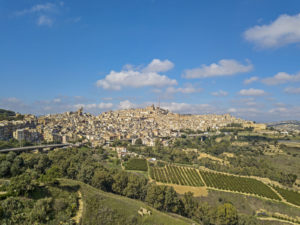Caltagirone boasts very ancient origins: the first settlements date back to the Neolithic Age.
Its strategic position high up in the hills brought the town centuries-long fortune.
Situated in the fertile plain between the Hyblaean and Erean Mountains, the Normans passed through Caltagirone and the Greeks and Romans before them. It has always been a very active city, with the work to renew not a consequence of the earthquake, but beginning much earlier.
Two main roads were built, one connecting the area of San Giorgio with San Giacomo and the other connecting the main church to the southern quarter.
The extraordinary Scalinata di Santa Maria del Monte (Staircase of St. Mary of the Mountain) was built during this new road organisation, which included a plan of streets at right angles.
 When seen from above, the town’s new layout was shaped like an eagle: the old quarter of the castle was its head, the quarters of San Giacomo and San Giorgio its wings, and the quarter of San Francesco its tail.
When seen from above, the town’s new layout was shaped like an eagle: the old quarter of the castle was its head, the quarters of San Giacomo and San Giorgio its wings, and the quarter of San Francesco its tail.
After the earthquake of 1693 Caltagirone was rebuilt on the same site and the previous road layout maintained. The city was enriched with splendid buildings and new architecture in blatant Baroque style, such as the church of Santa Chiara (St. Claire).